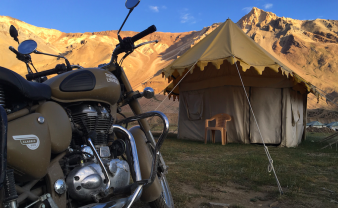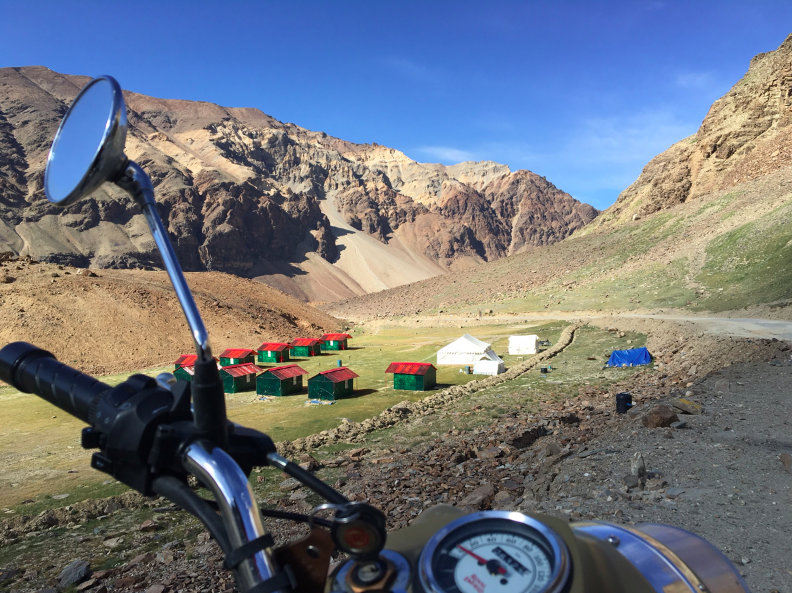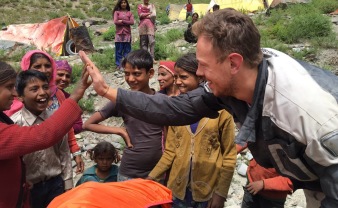An extreme motorbike trip through the Himalayas Part 2
“When you’re completely exhausted both mentally and physically, but have no option but to carry on, you discover that your body can do much more than you thought possible. Attitude is what takes you over the finish line.”
Continuing the story of Tinggly co-founder Linas Ceikus’ journey by motorcycle through the Himalayas, along some of the world’s most dangerous roads.

I woke up at 4 am from a nightmare. During this trip through the mountains, I would rarely sleep either calmly or deeply. And always in the back of my mind whether awake or not, the constant burr of motorcycle engines.
The bright morning sun lit up the mountain as we looked out of our hotel room’s window. The beauty on display was astounding – a snowy peak, deep furrowed crevices in the rock, and colourful flags flapping in the wind all around the town. It signalled time to continue our adventure.

The quality of the road was forever changing. Fresh solid tarmac became muddy and pitted track, then back again. Landslides would take over half the road, so we would need to angle the bikes around strewn rocks, and at points mountain rivers would overflow their banks, forcing us to ride through water which reached almost to our knees. Even though the Indian government invests heavily in infrastructure, very little can be done about these types of conditions – as soon as a new road is laid, a change of seasons can pull it all to pieces.

The landscape began to change. Mountains became darker grey, then even reddish. Into every valley, mountain rivers poured, sometimes three separate rivers joining in one place. In the peaks we could still see a lot of snow left from the winter, that before our eyes was forming immense waterfalls. At one white slope, we saw a group of local men enjoying an impromptu snowball fight.


By now, we were near the “Bara-lacha la” pass, said by some to be the deadliest mountain crossing in the world. It was hard to believe, but we were now 4890m high, at a greater elevation than the summit of Mont Blanc. Around us were even higher peaks. When we stopped to stretch our legs, we found it difficult to breathe, so thin was the air.
We tried to get across Bara-lacha la as quickly as we could. It’s not recommended to stay long on these crossings, or to climb higher without equipment, because you risk getting serious “mountain sickness.” We took aspirin preventatively, and kept swigging from our water bottles, but even so we were more than a little nervous of taking an accidental plunge over the mountainside.

Later, we began exploring in search of dinner. We found a small kitchen in a building made of stones with a tarpaulin roof. By 8pm, darkness shrouded everything. Crowds of travellers, many of them bikers, had now arrived, and began swapping “war stories.” Some were Indian, but again, we met people from every continent. The food was plain – soup, rice, dal, vegetable stew and bread, but we fell on it like starving wolves that have found a lost sheep.

Tents have no central heating, and because we were travelling by bike, we could only carry small, thin blankets with us. Nighttime temperatures regularly dropped as low as 5 Celsius, so we were forced to sleep fully clothed. Troubled by thoughts of mountain sickness and being found frozen like an icicle the next morning, I drifted off to an uneasy sleep, only to wake at 5am to the roar of bike engines starting up again.


Breakfast was served in the camp kitchen at 6.30. We ate our fill – today was going to be the hardest of all. We would travel 240km, making crossings at heights of up to 5300m. It felt like all the challenges we’d endured up to now had been building up to this point.
The road ahead was completely straight, and the views sublime. The road condition, however, left a lot to be desired. It was so bad we couldn’t accelerate past 25km/h for fear of wrecking our suspension. We passed a checkpoint – in this part of the Himalayas there are checkpoints every 50km. Officials need to know who is on the road, where and when, so that if anyone goes missing, they know where to start looking. In most cases, I assume, they start by looking over the side.



Arriving in Leh
The final day took us 12 hours, and I can honestly say, I’ve never felt more tired in my life than when I got off my bike that evening. For comfort, there was nothing but a cold shower, and a restaurant serving salad. Over dinner, we heard a rumour that the Dalai Lama himself would be visiting a local temple the following morning. Collapsing into bed, I knew that however tired I was, I couldn’t miss a chance to see him in person.





That event, right at the end of our journey, only served to confirm the dangers we had just faced. It could easily have been either Michal or myself at the bottom of that cliff, and just as easily we might not have been thrown from our bikes in time. In the Himalayas, sometimes your life hangs in the balance without you even knowing.
The Finish Line
A few days later, we flew home. Between bouts of sleep, I tried to sum up my thoughts and feelings from the trip:
We passed through scenes of shocking poverty that really cut at our emotions, but we had also witnessed incredible joy in the faces of people whose lives involve hardships we could only imagine.


We had been able to see the Dalai Lama up-close, watch him meeting his adoring people, yet this was only one of many incredible experiences that made up our adventure.
We had learned that when you’re completely exhausted both mentally and physically, but have no option but to carry on, you discover that your body can do much more than you thought possible. Attitude is what takes you over the finish line.
For years, I had dreamed of riding through the Himalayas, and putting myself to an awesome test such as this. Now I have proved to myself that I can do it, I turn my face to the horizon and the next experience.
https://www.youtube.com/watch?v=DAST7fzt21M
